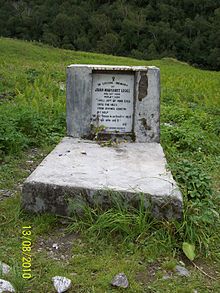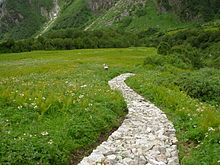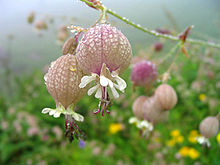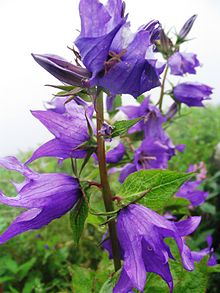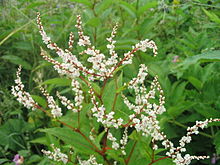- Valley of Flowers National Park
-
Nanda Devi and Valley of Flowers National Parks * UNESCO World Heritage SiteCountry India Type Natural Criteria vii, x Reference 335 Region ** Asia-Pacific Inscription history Inscription 1988 (12th Session) Extensions 2005 * Name as inscribed on World Heritage List
** Region as classified by UNESCOValley of Flowers National Park is an Indian national park, nestled high in West Himalaya, is renowned for its meadows of endemic alpine flowers and outstanding natural beauty. It is located in Uttarakhand state. This richly diverse area is also home to rare and endangered animals, including the Asiatic black bear, snow leopard, brown bear and blue sheep. The gentle landscape of the Valley of Flowers National Park complements the rugged mountain wilderness of Nanda Devi National Park to the east. Together they encompass a unique transition zone between the mountain ranges of the Zanskar and Great Himalaya. The park stretches over an expanse of 87.50 km². Both parks are encompassed in the Nanda Devi Biosphere Reserve (223,674 ha) which is further surrounded by a buffer zone (5,148.57 km²).[1] This Reserve is in the UNESCO World Network of Biosphere Reserves since 2004.
The Valley of Flowers is an outstandingly beautiful high-altitude Himalayan valley that has been acknowledged as such by renowned mountaineers and botanists in literature for over a century and in Hindu religion for much longer. Its ‘gentle’ landscape, beautiful meadows of alpine flowers and ease of access complement the rugged, mountain wilderness for which the inner basin of Nanda Devi National Park is renowned.
The Valley of Flowers is splashed with colour as it bloomed with hundreds of different flowers, taking on various shades of colours as time progressed. The valley was declared a national park in 1982 and now it is a World Heritage Site. The locals, of course, always knew of the existence of the valley, and believed that it was inhabited by fairies.
The valley is home to many celebrated flowers like the Brahmakamal, the Blue Poppy and the Cobra Lily. It is a much sought after haunt for flower-lovers, botanists and trekkers.
The Valley of Flowers is internationally important on account of its diverse alpine flora, representative of the Western Himalayan alpine shrub and meadows ecoregion. The rich diversity of species reflects the valley's location within a transition zone between the Zaskar and Great Himalayas ranges to the north and south, respectively, and between the Eastern Himalaya and Western Himalaya flora. A number of plant species are internationally threatened, several have not been recorded from elsewhere in Uttarakhand and two have not been recorded in Nanda Devi National Park. The diversity of threatened species of medicinal plants is higher than has been recorded in other Indian Himalayan protected areas. The entire Nanda Devi Biosphere Reserve lies within the Western Himalayas Endemic Bird Area (EBA). Seven restricted-range bird species are endemic to this part of the EBA.
The Valley of Flowers was declared a national park in 1982. This part of Uttarakhand, in the upper reaches of Garhwal, is inaccessible through much of the year. The area lies on the Zanskar range of the Himalayas with the highest point in the national park being Gauri Parbat at 6,719 m above sea level.
Contents
History and legends
The place had disappeared from the tourist map due to its inaccessible approach but in 1931 Frank S. Smythe a British mountaineer lost his way while returning from a successful expedition to Mt.Kamet and happened upon this valley which was full of flowers. He was so attracted towards the beauty of the place he named it the "Valley of Flowers". He authored a book called "The Valley of Flowers" which unveiled the beauty and floral splendours of the valley and thus threw open the doors of this verdant jewel to nature-enthusiasts all over the world.
In 1939 Miss Margaret Legge, a botanist deputed by the Royal Botanic Gardens Edinburgh arrived at the valley for further studies. While she was traversing some rocky slopes to collect flowers, she slipped off and was lost for ever. Her sister later visited the valley and erected a memorial near the spot. The memorial is still there.
Prof. Chandra Prakash Kala, a botanist deputed by the Wildlife Institute of India, carried out a research study on the floristics and conservation of the valley for a decade starting in 1993. He made an inventory of 520 alpine plants exclusively growing in this national park and authored two important books - "The Valley of Flowers - Myth and Reality" and "Ecology and Conservation of the Valley of Flowers National Park, Garhwal Himalaya'.
Management
There is no settlement in the national park and grazing in the area has been banned. The park is open only in summer between June and October, being covered by heavy snow during the rest of the year.[2]
Location
State: Uttrakhand
Exact location: The Valley of Flowers is nestled in the upper expanses of Bhyundar Ganga near Joshimath in Gharwal region and the old name of this valley was Bhyundar Valley.
District: Chamoli
Nearest town: Joshimath [1]
The trek
Getting to the Valley of Flowers requires a trek of about 17 km. The nearest major town is Joshimath in Garhwal, which has convenient road connections from Haridwar and Dehradun, both about 270 km from Joshimath.
Govindghat is a small place close to Joshimath (around one hour distance), from where the trek starts. From Gobindghat, a trek of 14 km brings trekkers to the Ghangaria, a small settlement located about 3 km from the valley. The valley starts near a gorge over the Pushpawati River.
Fauna
The park is home to tahr, snow leopard, musk deer, red fox, common langur, bharal, serow, Himalayan black bear, Himalayan brown bear, Pika (Mouse hare) and a huge variety of butterflies. Among the important birds and pheasant are, Himalayan Golden Eagle, Griffon Vulture, Snow Partridge, Himalayan Snowcock, Himalayan Monal, Snow Pigeon, Sparrow Hawk etc.
Flora
Flowers mostly orchids, poppies, primulas, marigold, daisies and anemones carpet the ground. Sub-alpine forests of birch and rhododendron cover parts of the park's area. A decade long study of Prof. C.P. Kala from 1993 onwards concludes that the Valley of Flowers endows with 520 species of higher plants (angiosperms, gymnosperms and pteridophytes), of these 498 are flowering plants. The park has many species of medicinal plants including Dactylorhiza hatagirea, Picrorhiza kurrooa, Aconitum violaceum, Polygonatum multiflorum, Fritillaria roylei and Podophyllum hexandrum.
Species
No. Name of Flowers Time of flowering 1. Rhododendron arboreum February–June 2. Primula denticuleta April–July 3. Iris kemaonensis June–July 4. Fritillaria roylei June–July 5. Lilium oxypetalum June–July 6. Arisaema costautum June–July 7. Thermopsisa barbata June–July 8. Rosa macrophylla June–July 9. Caltha palustris June–July 10. Fragaria nubicola May–July 11. Saxifraga roylei July–August 12. Anemone obtusiloba June–August 13. Cypripedium himalaicum June–August 14. Rheum australe July–August 15. Phlomis oracteosa June–August 16. Hackelia uncinata June–August 17. Senecio jacquemotiamus August–September 18. Ligularia amplexicaulis July–August 19. Morina longifolia July–September 20. Geum elatum July–August 21. Geranium wallichianum July–August 22. Impatiense sulcata July–August 23. Meconopsis aculeata July–August 24. Delphenium roylei July–August 25. Aconitum hookeri August–September 26. Thalictrum reniforme July–September 27. Potentilla atrosanguinea July–September 28. Sedum ewersii August–September 29. Dactylorhiza hatagirea June–July 30. Bistorta affinis August–September 31. Stachys sericee August–September 32. Nepeta connata August–September 33. Pedicularis hoffmeistri July–August 34. Swertia hookeri August–September 35. Gentiana ornata August–September 36. Gaultheria erichophy August–September 37. Codonopsis affinis August–September 38. Angelica cyelocarpa July–September 39. Leontopodium jacotianum July–September 40. Saussurea fastuosa July–September 41. Campanula latitotia August–September 42. Cyananthus lobotus August–September 43. Sassurea obvallata August–September 44. Cremanthodium ellisii July–September 45. Anaphalis triplineruts July–September 46. Inula grandiflora August–September 47. Aster albescens July–September 48. Selinium tenuifolium August–September 49. Heracleum pinnatum August–September 50. Epilobium latisperma August–September 51. Silene setisperma August–September 52. Arenaria griffithii August–September 53. Corydalis junecea August–September 54. Erigerono multiradiatus August–September 55. Polygonum molle August–September 56. Himalayan Blue Poppy July–September 57. Codonopsis viridis July–August 58. Origanus vulgare July–August 59. Hackelia uncinata July–August 60. Salvia hins/lanata July–August 61. Smilacina purpurea/oleracea June–July 62. Viola biflora June–August 63. Rhodiola heterodonta July–August 64. Epilohium latifolium July–August 65. Cotoneaster integrifolius July–August 66. Dubyaea hispida August–September 67. Saussurea costus July–August 68. Ligularia fiseheri July–August 69. Androsace museoidea July–August 70. Eritrichium conum July–August 71. Lindelofi anchusoides July–August 72. Thymus linearis June–August 73. Rheum webbianum June–August 74. Megacorpaea polyandra June–August 75. Trillidium govanianum June–August 76. Satyrium nepoleanse June–August 77. Podophyllum hexaneum June–August 78. Picrorhiza kurrooa June–August 79. Polygonatum multiflorum June–August Other attractions
How to reach
The nearest airport is in Jolly Grant, Dehradun, 295 kilometers (183 mi) away, and the nearest railway station is in Rishikesh, 276 kilometers (171 mi) away. The closest you can get to The Valley of Flowers by road is Govind Ghat. This requires around an 11 hour drive to Joshimath from Dehradun, then another one hour to Gobindghat. From Gobindghat it is a 13-kilometer (8.1 mi) trek along a steep, narrow, but well defined mountain trail to base camp at Ghangaria. This will take between 4 and 8 hours, depending on your fitness. Ghangaria has hotels with electricity and mobile towers. From Ghangaria, another 3 km trek leads to the valley.
See also
- Lakshman Ganga River
- Pushpawati River
References
- ^ World Conservation Monitoring Centre
- ^ Valley of Flowers Valley of Flowers.
2. Kala, C.P. 2005. Indigenous uses, population density and conservation of threatened medicinal plants in Protected Areas of the Indian Himalayas. Conservation Biology, 19 (2): 368-378. http://onlinelibrary.wiley.com/doi/10.1111/j.1523-1739.2005.00602.x/full
3. Kala, C.P. 2005. The Valley of Flowers; A newly declared World Heritage Site. Current Science, 89 (6): 919-920. http://www.ias.ac.in/currsci/sep252005/919.pdf
4. Kala, C.P. 2004. The Valley of Flowers; Myth and Reality. International Book Distributors, Dehradun, India.
External links
World Heritage Sites in India North Agra Fort · Buddhist Monuments at Sanchi · Fatehpur Sikri · Humayun's Tomb · Keoladeo National Park · Khajuraho Group of Monuments · Mountain Railways of India (Kalka-Shimla Railway)1 · Nanda Devi and Valley of Flowers National Parks · Qutub Minar and its Monuments · The Red Fort complex · Rock Shelters of Bhimbetka · Taj Mahal
Northeast East Mahabodhi Temple Complex at Bodh Gaya · Mountain Railways of India (Darjeeling Himalayan Railway)1 · Sun Temple at Konark · Sundarbans National Park
South Great Living Chola Temples at Thanjavur, Gangaikonda Cholapuram and Darasuram · Group of Monuments at Hampi · Group of Monuments at Mahabalipuram · Group of Monuments at Pattadakal · Mountain Railways of India (Nilgiri Mountain Railway)1
West Ajanta Caves · Champaner-Pavagadh Archaeological Park · Chhatrapati Shivaji Terminus · Churches and convents of Goa · Elephanta Caves · Ellora Caves · Jantar Mantar
1 Shared with other region/s• Part of the series on National Parks of India •

Andaman &
Nicobar IslandsAndhra Pradesh Arunachal Pradesh Assam Bihar Valmiki• Kanwar Taal Bird Sanctuary • Vikramshila Dolphin SanctuaryChhattisgarh Goa Gujarat Haryana Himachal Pradesh Jammu & Kashmir Jharkhand Karnataka Kerala Madhya Pradesh Maharashtra Manipur Meghalaya Mizoram Nagaland Orissa Rajasthan Sikkim Tamil Nadu Uttar Pradesh Uttarakhand West Bengal Coordinates: 30°44′00″N 79°38′00″E / 30.7333333°N 79.6333333°E
Categories:- Biodiversity hotspots
- Valleys of India
- National parks of Uttarakhand
- Himalayas
- Chamoli district
- World Heritage Sites in India
Wikimedia Foundation. 2010.


